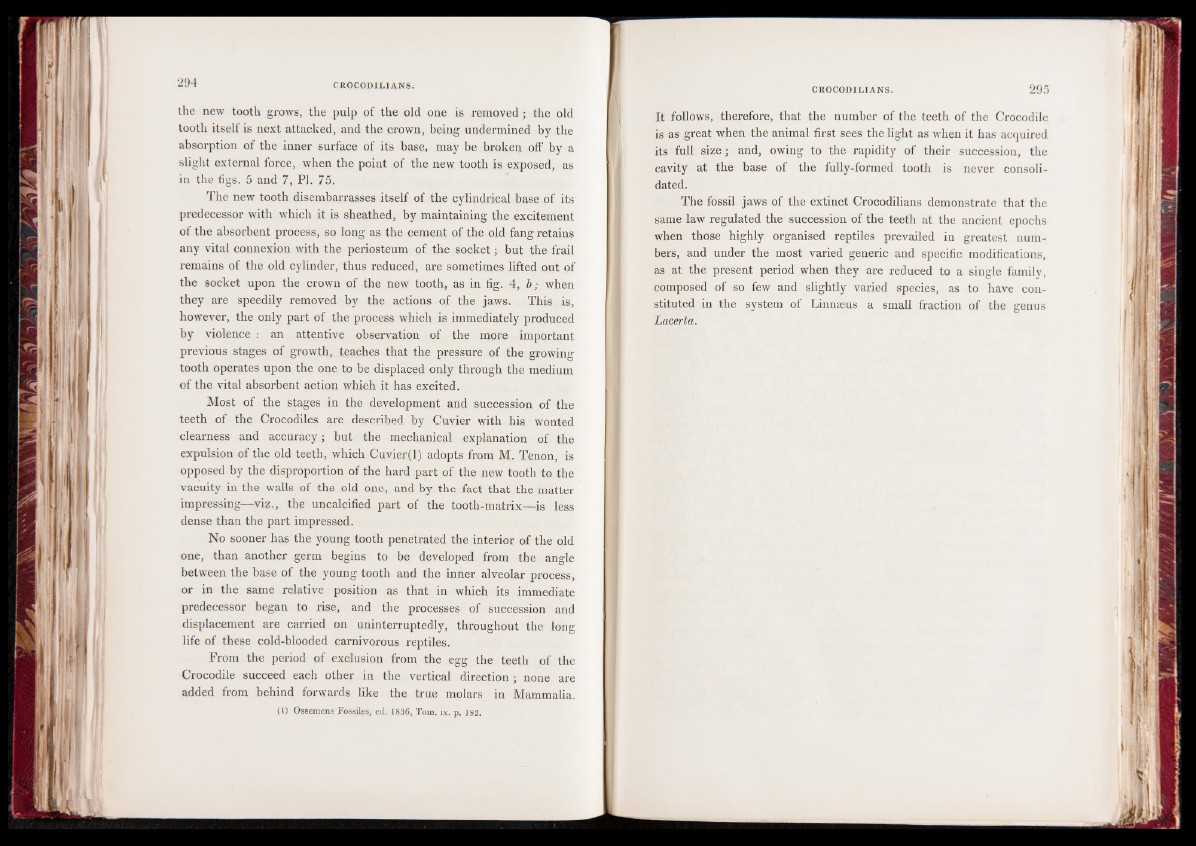
the new tooth grows, the pulp of the old one is removed; the old
tooth itself is next attacked, and the crown, being undermined by the
absorption of the inner surface of its base, may be broken off by a
slight external force, when the point of the new tooth is exposed, as
in the figs. 5 and 7, PI. 75.
The new tooth disembarrasses itself of the cylindrical base of its
predecessor with which it is sheathed, by maintaining the excitement
of the absorbent process, so long as the cement of the old fang retains
any vital connexion with the periosteum of the socket; but the frail
remains of the old cylinder, thus reduced, are sometimes lifted out of
the socket upon the crown of the new tooth, as in fig. 4, b; when
they are speedily removed by the actions of the jaws. This is,
however, the only part of the process which is immediately produced
by violence : an attentive observation of the more important
previous stages of growth, teaches that the pressure of the growing
tooth operates upon the one to he displaced only through the medium
of the vital absorbent action which it has excited.
Most of the stages in the development and succession of the
teeth of the Crocodiles are described by Cuvier with his wonted
clearness and accuracy; but the mechanical explanation of the
expulsion of the old teeth, which Cuvier(l) adopts from M. Tenon, is
opposed by the disproportion of the hard part of the new tooth to the
vacuity in the walls of the old one, and by the fact that the matter
impressing--Tviz., the uncalcified part of the tooth-matrix—is less
dense than the part impressed.
No sooner has the young tooth penetrated the interior of the old
one, than another germ begins to be developed from the angle
between the base of the young tooth and the inner alveolar process,
or in the same relative position as that in which its immediate
predecessor began to rise, and the processes of succession and
displacement are carried on uninterruptedly, throughout the long
life of these cold-blooded carnivorous reptiles.
From the period of exclusion from the egg the teeth of the
Crocodile succeed eaeh other in the vertical direction % none are
added from behind forwards like the true molars in Mammalia.
(1) Ossemens Fossiles, ed. 1836, Tom. ix. p. 182.
It follows, therefore, that the number of the teeth of the Crocodile
is as great when the animal first sees the light as when it has acquired
its full size; and, owing to the rapidity of their succession, the
cavity at the base of the fully-formed tooth is never consolidated.
The fossil jaws of the extinct Crocodilians demonstrate that the
same law regulated the succession of the teeth at the ancient epochs
when those highly organised reptiles prevailed in greatest numbers,
and under the most varied generic and specific modifications,
as at the present period when they are reduced to a single family,
composed of so few and slightly varied species, as to have constituted
in the system of Linnaeus a small fraction of the genus
Lacerta.